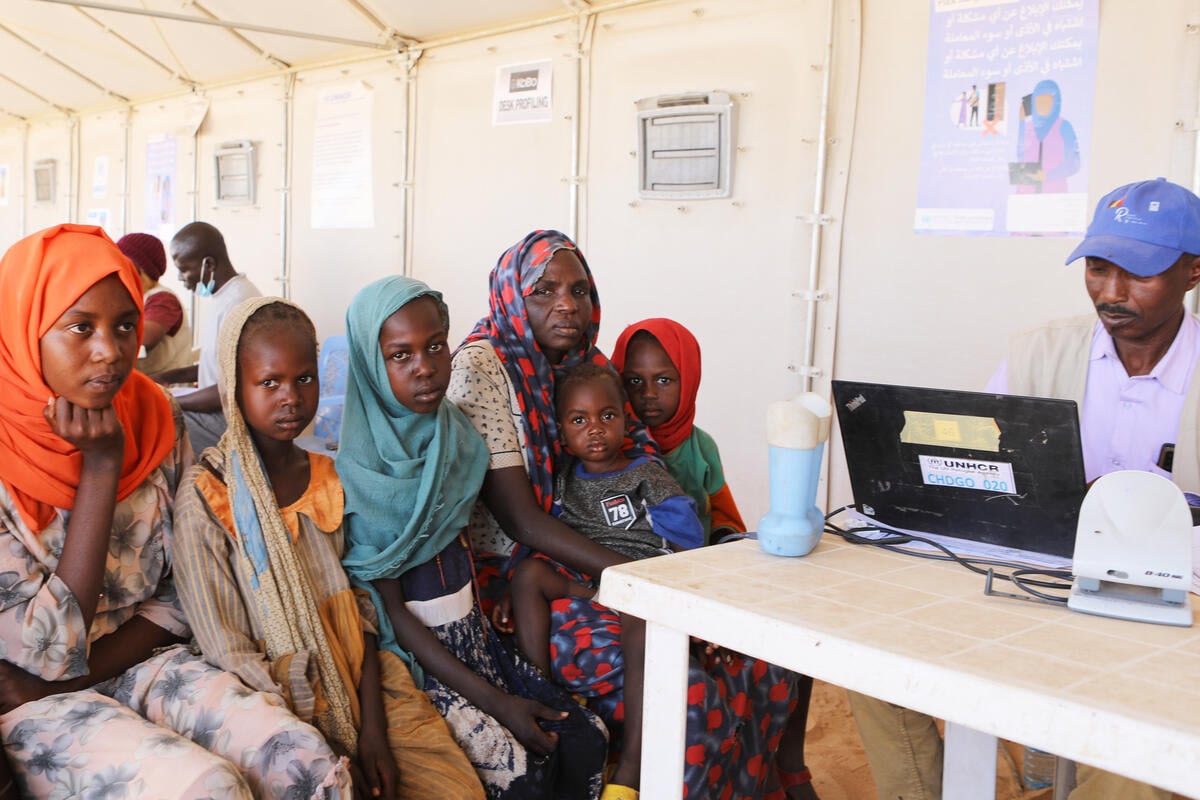Chad / Darfur / Cameroon / Central African Republic displacement
Chad / Darfur / Cameroon / Central African Republic displacement
Through yesterday, UNHCR convoys have so far managed to transfer 1,063 refugees who fled recent fighting in Sudan's Darfur region to Kounongou Camp in eastern Chad. The refugees are being picked up at pre-designated collection points along the remote and volatile Chad-Sudan border in the Birak region for the rough, 3- to 4-hour journey to UNHCR-run camps further inland in Chad.
Although tensions remain high along the border region, we have so far mounted five such convoys since March 6. A sixth is scheduled today. We're currently using six to eight trucks per convoy, but expect to increase that to 20 vehicles next week as we step up our efforts to move some of the estimated 13,000 refugees from Darfur who fled fighting that erupted in northern West Darfur in early February.
In addition to transfers to Kounoungou, we also plan to take some of the new arrivals to Mile Camp. The two camps, among a dozen UNHCR operates in remote eastern Chad, are both about 70 km away from the border, near the Chadian town of Guéréda. Kounoungou Camp already hosts 13,500 refugees from Darfur, while Mile has some 16,000 refugees.
Tensions remain high along the Chad-Sudan border and the constantly changing security situation regularly affects our relocation operation. On Wednesday, a UNHCR team organizing the transfer of refugees from Himera, near Birak, reported several loud detonations in the direction of the border, a few km away, and rushed the departure of the convoy. At the same time, another UNHCR team preparing a refugee convoy Bagar Katala, a few kilometres from Himera, had to hurriedly depart for Birak town amid the sound of sustained heavy explosions coming from the direction of the nearby border. Security along the border is also jeopardised by the continuing presence of various armed groups in vehicles and on horseback.
The refugees being transferred away from the border area to safer camps inland are part of a large group of some 13,000 Darfurians who arrived in Chad throughout February to escape aerial bombing and ground attacks by militia in the Jebel Moon area of West Darfur. They found refuge in and around 11 Chadian villages in the Birak area, including in Seneit, Figuera, Bagar Katala, Djatak, Himera.
Refugees interviewed this week said they had buried bags of grain in their villages in West Darfur before fleeing. Some had returned to their villages to find that their supplies had been discovered and destroyed by the Janjaweed militia, leaving them with nothing and forcing them to return to Chad. .Some of the refugees had previously fled Darfur for Chad in 2003-04, but had returned to Darfur in 2007 following inter-ethnic tensions in Chad between Zaghawas and Tamas. The latest fighting in northern Darfur has forced them to flee to Chad yet again.
UNHCR and its partners already take care of 240,000 Sudanese refugees from Darfur in 12 camps scattered across eastern Chad.
In northern West Darfur, meanwhile, UNHCR is carrying out field missions to the locations affected by the recent attacks as part of a joint UN assessment process to identify humanitarian needs. Over the past week, UNHCR teams visited Sirba, Abu Sourouj, Armankul, Tendelti, Sileah and Bir Saleeba in West Darfur.
In some areas, including Sirba and Abu Sourouj, the vast majority of the population has started to return to their villages, although some family members are still spread along the Chad-Sudan border. In Sirba, around two-thirds of the population is now home. About 90 percent have gone home in Abou Sourouj.
In other places like Sileah, the situation on the ground seems more complex. A few people have warily started to return, but the overwhelming majority remains in neighbouring areas of West Darfur and in Chad. Altogether, about 600 of the previous 20,000 residents of Sileah have gone home. Given the continued insecurity in the Sileah area, it is unlikely any mass returns will take place in the near future. In Armankul and Tendelti, the situation of displaced persons is stable. They have been provided with basic food and non food items.
Our teams also report that in the past three weeks, hundreds of Chadian have recently arrived in the Armankul and Abu Sourouj areas of West Darfur, reporting that they are fleeing inter-tribal violence in Chad.
Chad/Cameroon: Meanwhile in Cameroon, UNHCR has now moved some 8,400 Chadian refugees to Maltam Camp, 32 km away from the Cameroon town of Kousséri, opposite the Chadian capital of N'Djamena. Thousands of Chadians fled across the border river to Cameroon in early February to escape fighting between government forces and rebel groups in N'Djamena. They found refuge in Kousséri, a Cameroon border town on the Logone River.
Southern Chad/Central African Republic: UNHCR teams report that 3,000 more refugees from the northern Central African Republic (CAR) have crossed into Chad in the past two weeks, bringing the estimated total number of new arrivals to some 14,000 since the beginning of the year. Most stay in the area of Maya village, less than a kilometre away from the border, on the Chad side. We plan to begin the first refugee transfers today (Friday) to a temporary site near the village of Dembo, 25 km inland from the border where tents, blankets, plastic sheeting, jerry cans, and food aid will be distributed. The CAR refugees say they have been fleeing a fresh wave of armed raids, looting and house torching in the lawless reaches of north-eastern CAR. They blame most of the violence on rival armed groups and on the zaraguina - bandits, who rustle cattle and abduct children for ransom.








